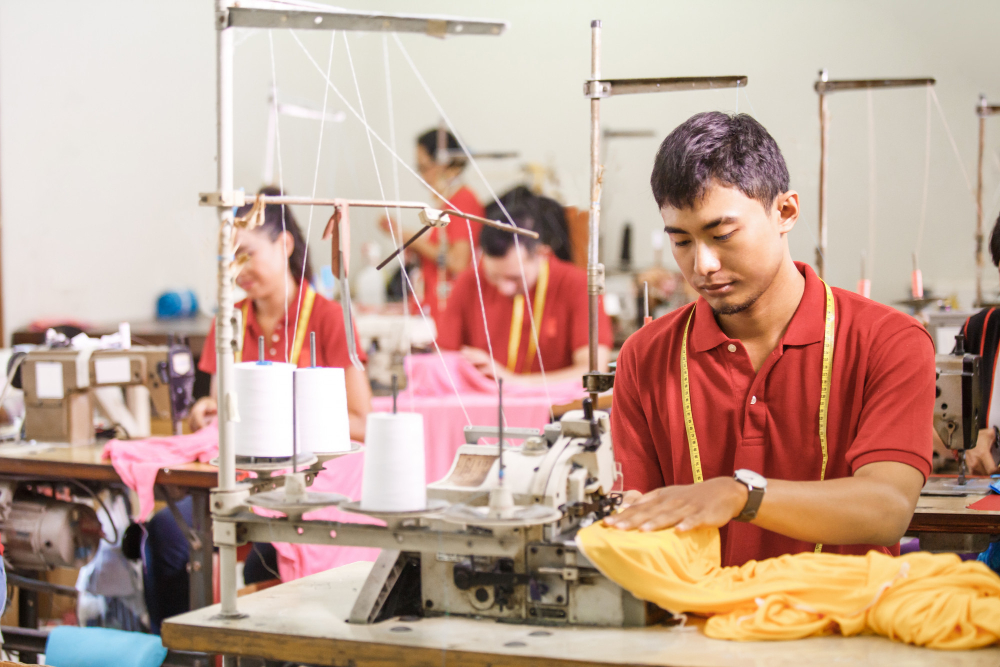Summary
- The garment industry moves fast. It connects trends, people, and markets around the world.
- But behind the scenes, it also faces serious challenges, from rising costs to global competition.
- Overcome industry hurdles with the power of fashion technology. Try Audaces360 for free!
China plays a major role in the global fashion industry. Its industrial production powers the making of clothes for brands around the world. Today, many fashion businesses depend on China’s factories, machinery, and workforce to keep up with demand.
Now, here are some important questions: Do you know exactly how this system works? And what impact does it have on the way we produce and deliver fashion?
In this article, we’ll explore the main fashion hubs in the country. We’ll also explain how production in these regions shapes the global fashion supply chain.
This topic is certainly worth your attention. We hope you enjoy the read!
Sumário
What is the impact of China industrial production?
China industrial production offers fast, large-scale, and cost-effective solutions for brands around the world. From fabric making to garment assembly, every step of the process is quick and efficient.
This strong structure gives China an edge. The country’s manufacturing sector combines skilled labor, advanced machines, and a wide supply chain. This allows companies to meet high demand and follow fashion trends with speed.
For the country
Industrial production drives China’s economy. It creates millions of jobs and supports many local businesses. Cities grow around factories, and people move there to work.
The textile industry is one of the oldest and strongest in China. Over time, it has become more modern and global. Many regions now focus on fashion production, especially in knitwear, denim, and sportswear.
Moreover, the government supports this growth. It invests in technology, training, and export policies. These actions help Chinese companies become leaders in textile manufacturing.
For the world
Its fast production times allow companies to launch new collections often. This supports the fast fashion model and increases product variety.
Many countries depend on China for materials and final products. It keeps prices low and makes fashion more accessible. This is key for both large brands and small businesses.
However, there are risks in this global setup. Supply chain issues, delays, and over-dependence on one country can affect the whole fashion industry. Still, China continues to be a vital partner. Its scale, skill, and speed are hard to match.
As the world looks for balance, China remains at the center of global textile production.
Learn more: What is the fashion industry, its value, and key players?
A brief history of China industrial production
China’s textile industry boasts a history spanning thousands of years. Silk production began around 2700 BC, establishing China as a major trading power through the Silk Road.
In the 19th century, Shanghai emerged as a textile hub, marking China’s industrial revolution. The result was the city’s transformation from a fishing village into an urban center.
Post-1949, under the People’s Republic of China, the textile industry was nationalized, leading to significant expansion. However, it wasn’t until the economic reforms of the late 1970s that the industry expanded its global reach.
China’s accession to the World Trade Organization in 2001 further accelerated the growth of its textile industry. It was at that point that the country became the world’s largest exporter of textile goods.
Today, China’s textile industry is not only a cornerstone of its economy. It’s also a critical player in the global fashion supply chain. The sector continues to evolve, embracing technological advancements to meet global demands.
Learn more: How to boost production capacity in fashion manufacturing?
Key data on China industrial production
China industrial production demonstrated strong growth in March 2025, increasing by 7.7 percentage points year-on-year. This figure surpassed market forecasts, which had anticipated a 5.6% rise.
It also marked an acceleration from the 5.9% growth observed during the combined January-February period.
Separately, data from the National Bureau of Statistics (NBS) showed that in December 2024, the total retail sales of consumer goods in China reached 4,517.2 billion yuan. It represents a 3.7% year-on-year increase.
The retail sales of other consumer goods saw an even greater rise of 4.2%, reaching 3,950.9 billion yuan.
Learn more: How can mass production boost your apparel manufacturing?
Leading hubs for fashion industrial production in China

Guangdong
Guangdong is a major manufacturing base for clothing and textiles. The province’s clusters, especially in the Pearl River Delt, focus on finished garments. This is often fast-fashion and high-end apparel, as well as fabrics for clothing and home textiles.
The industry is highly industrialized and export-oriented, with many factories supplying global brands.
This region ships a large share of its products, especially to markets in North America, Europe and Southeast Asia. The logistics contribute to it, since the province is close to Hong Kong, seaports, and large domestic apparel markets.
Zhejiang
Zhejiang factories make a wide range of products. It goes from woven and knitted fabrics to dyed and printed cloth, as well as finished garments and home textiles.
The province is also famous for smaller specialty clusters. Many Zhejiang factories serve both domestic brands and export clients.
Learn more: Main types of factory layouts and tips for your production
Jiangsu
This is the cornerstone of China’s textile industry. It has a comprehensive supply chain and is strong in chemical fibers, like polyester and nylon.
Jiangsu’s strengths are its scale, integration and innovation. Its textile parks include advanced facilities for spinning, weaving, printing, and garment making.
Want to take your company to the next level and reach peak productivity? Download our free exclusive guide filled with golden tips to get you there!
Fujian
Fujian’s fashion industry centers on footwear and apparel manufacturing. The cities of Quanzhou and Jinjiang in southern Fujian form the country’s largest sports and leather footwear cluster.
The products range from leather boots to canvas sneakers under many international brands. Fujian is also famous for its garment districts. For example, Shishi, in Quanzhou, has over 10,000 factories focused on fast-fashion trousers, jeans and shirts.
Sportswear, underwear and men’s clothing are other common products from Fujian factories.
Shandong
Shandong has become a major textile hub in northern China. It leads in spun yarn and woven fabrics, especially cotton-based and denim products.
While it doesn’t emphasize cutting-edge fashion, Shandong’s industry is competitive in low- to mid-range textile products.
Hebei
Hebei’s textile and apparel sector is smaller than those of China’s coastal provinces but still significant. The province produces cotton yarns, woven and knitted fabrics, and garments.
Hebei is particularly famous for related industries. For example, Baigou town in Hebei is China’s largest leather luggage and accessories manufacturing hub.
While export data are less highlighted for Hebei, the region benefits from national initiatives to develop textile parks.
Xinjiang
The province is China’s premier cotton base, and its textile industry reflects that. The region produces most of the China’s cotton.
Xinjiang also processes wool from sheep and goats, and silk. It also has garment facilities that make cotton clothes, knitwear and down outerwear.
As a result, common products include cotton yarns, blended fabrics and simple cotton garments.
Learn more: 4 key steps to streamline your fashion production process
How is technology modernizing the country’s industrial production?

Artificial Intelligence in product development
Artificial Intelligence is changing how professionals design fashion products in China. With AI, companies can predict trends faster and respond to market needs in real time.
Designers now use AI to test colors, styles, and patterns before making a sample. This saves time and materials.
High-capacity mass production
With better machines and systems, factories can now produce even more items in less time. This is key for meeting global demand.
New technology helps plan each step of production. Digital systems monitor speed, output, and quality. This reduces delays and avoids mistakes.
Advanced automated machinery
Automation is one of the biggest changes in China’s textile production. Many steps that once needed people can now rely on modern equipment. These machines work faster and with great accuracy. They also need fewer breaks, which means more output every day.
Some of them can even check for errors in real time. They adjust automatically to keep quality high. This reduces waste and makes the final product better.
With automation, China keeps its edge in global fashion manufacturing
Learn more: Boost your garment manufacturing with industrial management
Automate your industrial production with Audaces solutions
Learn how Audaces solutions support every stage of the garment industry!
Audaces360
Audaces360 integrates cutting-edge digital innovations to optimize workflows in the textile and apparel industry.
It caters to companies of all sizes and types, offering the flexibility to scale with your business needs.
All solutions were carefully developed to address the specific challenges of the field. They streamline the design and production processes, saving valuable time and resources.
The platform boasts a comprehensive range of functionalities, including pattern making, marking, collection management, vector drawing, and 3D creation.
In addition, a fashion Artificial Intelligence to assist you along the way.
Audaces Cutting Room
By embracing cutting-edge technology, garment manufacturers can achieve significant improvements in the production process. From greater design flexibility to enhanced efficiency and reduced costs.
This is where Audaces Cutting Room steps in! Our experts will thoroughly assess your company’s needs and create a comprehensive report.
Then, our team will develop a personalized project to achieve your goals and unlock your company’s full potential.
Rely on Audaces’ cutting-edge machinery to automate your production process. Achieve impeccable cuts on curves and details, speeding up your deliveries and minimizing fabric waste through automation.
Want to stay up to date on the latest fashion industry news? Subscribe to our newsletter!
FAQ
China industrial production offers fast, large-scale, and cost-effective solutions for brands around the world. From fabric making to garment assembly, every step of the process is quick and efficient.
Some leading hubs for fashion industrial production in China include Guangdong, Jiangsu, Shandong, and Xinjiang.
Artificial Intelligence in product development, high-capacity mass production, and advanced automated machinery.





